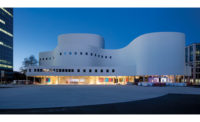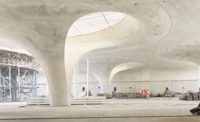The gleaming, rectilinear glass-and-wood Lanserhof Tegernsee, a resortlike spa clinic nestled in the Bavarian countryside, seeks to regenerate the health of its clientele. Its Alpine surroundings and contemplative atmosphere bring to mind Thomas Mann’s sanitarium in his novel The Magic Mountain—only the patients in the fictive Swiss institution had to contend with tuberculosis. Here, health concerns might include more subtle ailments derived from the stress and indulgences of contemporary life. Germany has long been the wellspring of such restorative resorts, dating as far back as the 2nd century CE, when the Romans happened upon the hot springs that became known as Baden-Baden. Times have changed, but the desire for taking a cure has not.
While Mann’s cast of characters were a representative assortment of early 20th-century European cosmopolites, the clientele at Lanserhof Tegernsee comes from all over the world—and is likely to be extremely well-heeled, literally: a famous designer of ultrachic shoes was a recent guest—as well as a top interior decorator from Paris, the head of a major auction house in New York, and the daughter of an English duke. In fact, Lanserhof Tegernsee’s architect, Christoph Ingenhoven, has frequented the place, which opened in 2014 as part of a cluster of medical resorts originally formed in Lans, Austria, over 30 years ago. The brief for the Dusseldorf-based firm of Ingenhoven Architects was to provide a state-of-the-art facility in a luxurious (but low-key) hotel, 260,000 square feet, in this pastoral landscape south of Munich. Its 70 bedrooms and suites range from 600 to over 1,000 square feet.
The stay at any Lanserhof inn, however, involves a fair amount of deprivation for its guests in terms of food and drink. Inspired by the teachings of the Austrian physician Dr. Franz Xaver Mayr (1875–1965), the regimen involves therapeutic fasts and special detoxifying diets that promise to rejuvenate the metabolic system and boost wellbeing. And you’ll lose weight—although, the architect says, “Eighty percent of the guests do not need to reduce—just change their lifestyle. It’s not a spa,” he adds, “but more like a clinic, with medical treatments.”
In planning this facility, the owners purchased a golf course with dramatic views of the Alps and placed the new building on a hill. In developing the scheme for the 260-by-260-foot-square three-story structure, which is organized around an inner garden, Ingenhoven was inspired by the area’s monasteries and large farmhouses with courtyards. Moreover, the rough climate and strong winds of the locale encouraged him to think of the inward-turning plan.
The winds and the fact that most guests tend to get cold easily—because of their low-calorie diet—convinced Ingenhoven to design a poured-in-place reinforced-concrete structure that would provide thermal mass. And concrete’s acoustical properties assure peace and quiet. Oak is used for floors and decks, while larch wood clads exterior and interior surfaces. Sliding screens across the private balconies give the facility a domestic look, enhanced by the planting on the inner walls of the courtyard and on the roof.
Both the client and architect wanted natural materials—minus synthetics, chemicals, or toxins—with a neutral color scheme, as befit a clinical program. Plush upholstery for the seating adds the proper sense of comfort. In turn, the white-on-white palette in the bedrooms and baths imbues them with a sense of purity and serenity without visual distraction. The medical clinic, entered through the courtyard or via a corridor from the hotel, is pristine white throughout, except for what is known as the “Blue Sofa”—an enormous azure-hued seating area where guests meet for their various treatments and consultations. An adjoining bathhouse, reached via an underground passage, offers a zen-like yoga studio, a gym with the latest equipment, and a sauna, as well as indoor and outdoor pools.
Ingenhoven’s firm executed the entire design, including the interiors. “It’s a gesamtkunstwerk,” says the architect. A range of sustainable features—geothermal heating and cooling, triple-glazed windows, the living walls on the courtyard’s inner facades, and the planted roof that reduces solar loads—accord with Ingenhoven’s green reputation.
The day at the medical spa begins by drinking a mixture of Epsom salts. These—along with 25 bitter drops of some sort of potion ingested before every meal—ensure that your cleansing stay is not the normal fun holiday. Naturally, no alcohol, caffeine, or sugar are allowed, but once you make it past the third day, you start to feel healthier. Breakfast, served at 7 a.m. in the dining room, is small: some have tea; others have porridge or gluten-free bread (each bite of which must be chewed 25 times). The morning program includes medical diagnostics with staff doctors.
The rest of the day—if you have the energy, since the minimal diet lowers your metabolism—you may golf, bike, go on a “Nordic walk” (sticks provided; in winter, snowshoes as well), or take fitness or yoga classes. The hikes are invigorating, as well as occasionally tempting when one passes the gemütlich beer hall in the nearby village that beckons with its brew and bratwurst.
To help in the detoxing of one’s digestive system, the medical spa gives its guests white hot-water bottles (rather chic, actually) to place over the abdomen for 20 minutes twice daily while reclining on a bed fitted with organic linens. Dinner is over by 6:30 p.m., at which point you may attend a concert or a lecture in the lobby and knock back medicinal teas. Yes, you go to bed hungry, but the atmosphere is very conducive to resting. In the rigorously restrained chasteness of this modern monastery you do feel coddled by the design. You depart feeling lighter—mentally as well as physically—with a resolve to come back. Someday.
PeopleArchitect: ingenhoven architects Engineers: Structural Engineering: Binnewies, Hamburg Consultants Facade Consultant: DS-Plan AG, Stuttgart Photographer: H.G. Esch, Hennef/Alexander Haiden Client: Lanserhof Marienstein Size: 226,000 square feet Cost: withheld Completion date: January 2014
|
ProductsStructural System Reinforced Concrete Exterior Cladding Metal panels: Facade Bathhouse: Riegler Metallbau GmbH (Executive Company) Wood: Facade Main Building: Rubner Holzbau GmbH (Executive Company) Other cladding unique to this project: Inner courtyard covered with greenery: Freisinger Holzbau GmbH (Executive Company) Roofing Built-up roofing: Dachtechnik Winschüttl GmbH (Executive Company) Metal: Steel Construction Canopies: Amrobsi Metallbau GmbH (Executive Company) - Special Colour Alucubons: "Havanna" Windows Wood frame: Facade System: RAICO Bautechnik GmbH (Executive Company) Glazing Glass: Glass Construction (interior walls): Foidl Bau- und Kunstglas GmbH (Executive Company) Doors Entrances: Custom-made Metal doors: Eisenkies GmbH & Co. KG (Executive Company) Wood doors: Inner doors: Markus Schober Innenausbau und Bodendielen GmbH (Executive Company) Sliding doors: Rooms: Hagenauer GmbH (Executive Company) Fire-control doors, security grilles: Revolving doors: Hörmann KG (Executive Company) Special doors: Telescope sliding gate: Jansen Holding GmbH (Manufacturer) Upswinging doors, other: Hardware Locksets: Locking System: ESS-Systeme GmbH (Executive Company) Interior Finishes Acoustical ceilings: Baierl+Demmelhuber Innenausbau GmbH (Executive Company) Paints and stains: Painting: Hierat GmbH (Executive Company) Wall coverings: Bachhuber Einrichtungen GmbH (Executive Company) Plastic laminate: Egger Building Products GmbH (Executive Company) Solid surfacing: Corian in different colours Special surfacing: Burnished brass Floor and wall tile: Floor and Wall coverings Carpet: Ruckstuhl AG, series "Madison" Furnishings Office furniture: Vitra series "Adhoc" Reception furniture: Custom-made Fixed seating: Custom-made Chairs: Vitra "Softshell Chair" Tables: Custom-made Upholstery: Sofa: Flexform S.p.A. "Soft dream" Other furniture: Outdoor furniture: KETTAL "Bitta" (Manufacturer) Lighting Interior ambient lighting: XAL GmbH (Manufacturer) Exterior: BEGA Gantenbrink-Leuchten KG Deutschland Dimming system or other lighting controls: Conveyance Elevators/escalators:Kone AG (Executive Company) |














Post a comment to this article
Report Abusive Comment